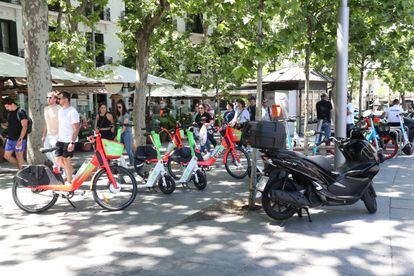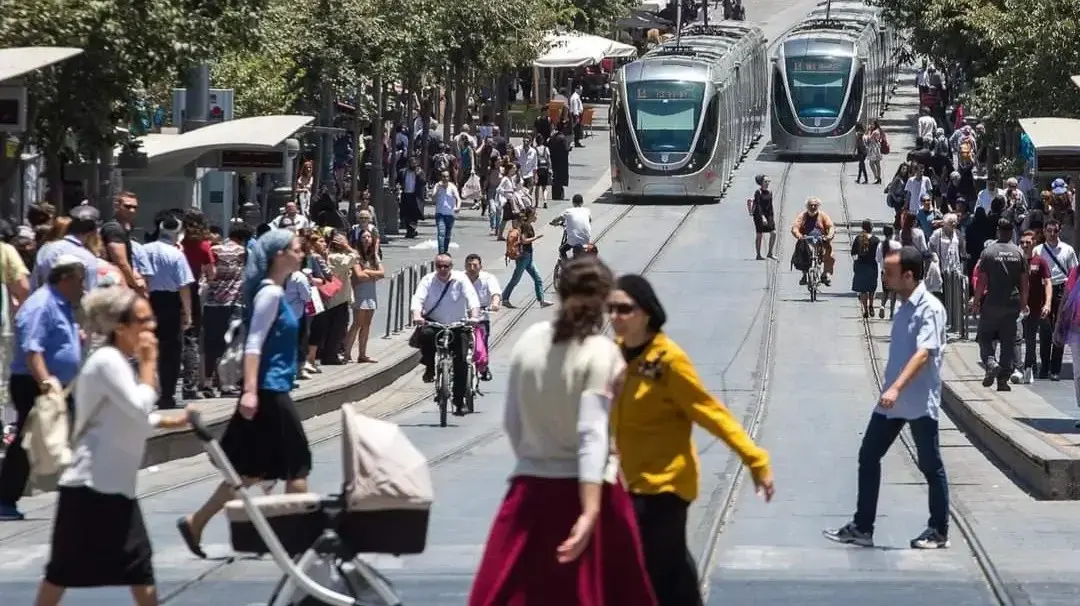The sidewalks, which should be quiet spaces to walk and sit, are now the scene of an uphill battle that pits pedestrians with scooters, parked motorcycles, bike riders and vans from Amazon — and other companies — climbing the curb "a minute." The war for this public space has led Paris to ban electric scooters for rent – something that Barcelona or Valencia already do – but it goes much further: these new actors in urban mobility and terraces, which do not stop expanding, represent an attack on walkers, who a century ago lost their right to use most of the city – given over to cars. Experts in mobility and urban planning ask to rethink the capitals to put the walker in the center, while pedestrian associations accuse municipalities of not stopping breaches.
"At the beginning of the twentieth century, the arrival of cars in Spanish cities was an abrupt shock for citizens: they were going very fast, people were not used to it and there were many fatal accidents. The sidewalks were created and it was necessary to discipline the walkers, who previously could walk throughout the city, to only move through that small space, "explains Nuria Rodríguez Martín, professor of Contemporary History at the Complutense University of Madrid (UCM). "There is a parallel with the current situation: new vehicles, scooters, electric bikes, motorcycles appear, and they begin to compete for pedestrian space, which is already small. And that alters coexistence," continues this expert in urban history.
Scooters, bicycles and motorcycles parked on a sidewalk in the center of Madrid; In the background, several terraces. Jaime Villanueva
"Public space is a disputed space that represents the powers of the city", says Zaida Muxí, urban planner and professor at the Barcelona School of Architecture (ETSAB-UPC). "The pedestrian is always the last, the one that matters least, even though we are all pedestrians at some point," he continues. Rodríguez Martín resumes: "From the beginning, pedestrians have been disorganized, while the Royal Automobile Club of Spain (RACE) was created in 1903. The drivers have the support of strong pressure groups and are believed to contribute money (taxes, fines), while the pedestrian seems to contribute nothing. " In fact, the professor has found that in the twenties pedestrians were blamed for the outrages and even caricatures were published in which passers-by ran over cars.
David Lois, professor of Social Psychology at the UNED, provides another idea: "The sidewalks have two functions, the transit, because they facilitate walking, and the estancial, because they allow rest. What makes a sidewalk pleasant is a generous width, that is green, that has trees, that allows sufficient isolation from road traffic, noise, pollution ...".
More informationCharging 800 euros a year to cycle to work: in the Netherlands and France it is already done, in Spain it is still an idea
What does it translate into? "As for the former, they must be accessible and facilitate direct and well-connected routes; If people perceive them that way, that makes them walk more. Regarding the second, the pedestrian space makes people meet their neighbors, and that strengthens ties with the neighborhood and increases social trust; for this, benches designed for rest are needed", continues the also mobility expert from Transyt-UPM.
Atocha Street in Madrid, whose pedestrian extension is full of terraces. Jaime Villanueva
In general, the historic centers of most Spanish cities have experienced progressive pedestrianization processes – largely driven by tourism and gentrification – which does not always mean more space to walk. A walk along Atocha Street in Madrid, renovated in 2018 to "expand the pedestrian space", exemplifies many of these evils: on the corner with Paseo del Prado, dozens of parked motorcycles prevent the passage; There are also rider bikes waiting to pick up orders, one of which pedals down the sidewalk. Two scooters from a rental company remain lying on the ground, while a young man with headphones, mounted on another, speeds past passers-by. A delivery van climbs onto the curb and its driver gets off to deliver a small package to a nearby address. The pedestrian space obtained after the reform is mostly occupied by the terraces of several bars and restaurants in the area. People walk in a hurry, they don't feel like standing here. The only bench installed in this lower part of the road has no backrest, so no one occupies it.
Symptom of inequality
"Sidewalks are a great symptom of inequality," criticizes urban planner Antonio Giraldo. "They belong to all citizens, but not everyone can enjoy them in the same proportion: in general, there are wide and very well-kept sidewalks in the central or rich neighborhoods, but in the periphery they often have to settle for narrow sidewalks, very deteriorated, which do not meet the basic accessibility criteria, "adds the now candidate of the PSOE to the City Council of the capital.
Two Glovo couriers (or 'riders') wait to take an order on a street in the center of Madrid. Jaime Villanueva
What are those criteria? According to Order TMA/851/2021 of the Ministry of Transport, to be accessible, all urban sidewalks must be at least 1.80 meters wide and cannot be parked on. That width is not met on many small streets, usually because it is preferred to maintain a lane for cars and a parking strip instead of replacing them with pedestrian or single-platform options – where the road and sidewalk are at the same height and cars must circulate at most, at 20 per hour.
Many municipalities – such as those of Madrid, Barcelona, Valencia or Zaragoza – allow motorcycles to park when the pedestrian space exceeds the width of three meters. However, those who park in narrower places are not always sanctioned. The same happens with the parking of bicycles and electric scooters. It is not easy to obtain data on breaches on the sidewalks, given that in the large consistories their competences are distributed among several departments (mobility, works, security, commerce ...).
A delivery driver parks his van on a sidewalk in the center of Barcelona. MASSIMILIANO MINOCRI
As an example, in 2022 Madrid fined 138,750 shared mobility vehicles for parking poorly (11,273 less than the previous year): 68.4% were scooters; 20.4 per cent were motorcycles and 11.2 per cent were bicycles; Valencia sanctioned 11,914 vehicles (1,063 were motorcycles) and Bilbao did the same on 3,435 occasions; Malaga fined 4,554 vehicles (1,226 scooters). Barcelona, Zaragoza and Seville do not offer data.
Those scooters parked anywhere almost always belong to large companies. The problems generated in many cities have led some consistories to not allow its use: this is the case of Barcelona, Valencia and Valladolid. "We bet on walking and cycling. The scooter is a sedentary environment, from door to door, and many of its users come from public transport. We are not interested," says a spokesman for the Valladolid City Council. In Madrid, on the other hand, 18 companies have operated for years, but since May 3 only three have permission to do so.
Pedestrian abuse
Meanwhile, the General Traffic Regulations, updated in 2022, prohibit scooters, bicycles and any other vehicle from circulating on the sidewalks. Something that continues to happen. "The current sidewalks are clear proof of the mistreatment suffered by pedestrians in public space, they are occupied by all kinds of vehicles and terraces, which usually cover more than the license allows," denounces Sonia Jichi, president of Andando, which brings together a score of Iberian pedestrian associations. "This situation is not accidental, but the result of policies that have allowed a car-centric urban design, based on giving more space to the private car and less to the walker. The universal pedestrian accessibility included in the Constitution is being despised by the administrations, "he continues.
Two young people walk along a narrow sidewalk in Barcelona where several motorbikes are parked. MASSIMILIANO MINOCRI
Journalist Charles Montgomery provides another clue in his recent Happy City (Captain Swing): cars speeding on the road exert "a painful influence on the psychology of public space." A study studied three identical streets in San Francisco but with different traffic intensities (low, medium and high), and found that in the first street children played on the sidewalks and people stopped to chat, while in the second the social activity decreased, and in the third there were practically no social interactions.
A dealer parks on the sidewalk of Atocha Street to leave merchandise; In the background, terraces of several premises. Jaime Villanueva
The spokeswoman for Andando also denounces the little control that exists in most Spanish cities with the terraces of bars and restaurants: "The terraces are a privatization of public space, they are increasingly extended, and the municipalities should monitor their use, how many there are per street, that they leave space to pass comfortably ... There are terraces that occupy bus stops, space to walk, and that do not allow you to pass through some streets." For example, in 2022 Madrid has imposed 1,820 sanctions on hoteliers for this reason; Valencia, 1,585; Saragossa, 300; Malaga, 205 and Bilbao, 78. Barcelona does not offer data.
Zaida Muxí believes that change will come, even if it costs: "There have been pedestrianizations in historic centers of many cities; With the success they have had, it is surprising that it costs so much to expand sidewalks in other urban areas." And he gives positive examples: "The city that is betting the most on this is Barcelona, which is making pedestrianizations inside the superblocks not only in tourist areas, but in all kinds of neighborhoods, turning what was asphalt into spaces for play, safe stay, with trees and without pollution. Valencia has also widened sidewalks with tactical urbanism, and the same is being done in Paris, Vienna, Copenhagen ... In the end it will spread." That requires political will. While it arrives, walkers must continue fighting for their space.
You can follow CLIMA Y MEDIO AMBIENTE on Facebook and Twitter, or sign up here to receive our weekly newsletter
Subscribe to continue reading
Read without limits
Read more
I'm already a subscriber


/cloudfront-eu-central-1.images.arcpublishing.com/prisa/YXAWAIRRD5BZPJZAQFJ26QP7IA.jpg)



